Steering
 |
Part of car steering mechanism: tie rod, steering arm, king pin axis (using ball joints) |
Steering is the collection of components, linkages, etc. which allows any vehicle (car, motorcycle, bicycle) to follow the desired course. An exception is the case of rail transport by which rail tracks combined together with railroad switches (and also known as 'points' in British English) provide the steering function.The primary purpose of the steering system is to allow the driver to guide the vehicle. |
Bell-crank steering linkage |
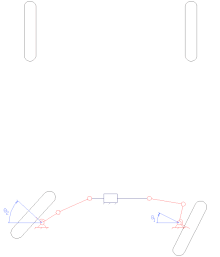 |
Rack-and-pinion steering linkage |
Introduction
The most conventional steering arrangement is to turn the front wheels using a hand–operated steering wheel which is positioned in front of the driver, via the steering column, which may contain universal joints (which may also be part of the collapsible steering column design), to allow it to deviate somewhat from a straight line. Other arrangements are sometimes found on different types of vehicles, for example, a tiller or rear–wheel steering. Tracked vehicles such as bulldozers and tanks usually employ
differential steering — that is, the tracks are made to move at different speeds or even in opposite directions, using clutches and brakes, to bring about a change of course or direction.
Wheeled vehicle steering
Basic geometry
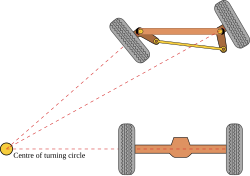 |
Ackermann steering geometry |
 |
Ackerman steering linkage |
 |
Caster angle θ indicates kingpin pivot line and gray area indicates vehicle's tire with the wheel moving from right to left. A positive caster angle aids in directional stability, as the wheel tends to trail, but a large angle makes steering more difficult. |
he steering linkages connecting the steering box and the wheels usually conform to a variation of Ackermann steering geometry, to account for the fact that in a turn, the inner wheel is actually travelling a path of smaller radius than the outer wheel, so that the degree of toe suitable for driving in a straight path is not suitable for turns. The angle the wheels make with the vertical plane also influences steering dynamics (see
camber angle) as do the tires.
Rack and pinion, recirculating ball, worm and sector
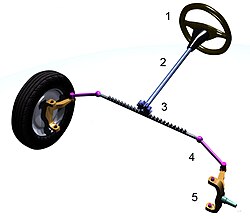 |
Rack and pinion steering mechanism: 1 steering wheel; 2 steering column; 3 rack and pinion; 4 tie rod; 5 kingpin |
 |
Rack and pinion unit mounted in the cockpit of an Ariel Atom sports car chassis. For most high volume production, this is usually mounted on the other side of this panel |
 |
Steering box of a motor vehicle, the traditional (non-assisted), you may notice that the system allows you to adjust the braking and steering systems, you can also see the attachment system to the fram |
began to use rack and pinion steering systems in the 1930s, and many other European manufacturers adopted the technology. American automakers adopted rack and pinion steering beginning with the 1974 Ford Pinto.
Older designs use two main principles: the worm and sector design and the screw and nut. Both types were enhanced by reducing the friction; for screw and nut it is the recirculating ball mechanism, which is still found on trucks and utility vehicles. The steering column turns a large screw which meshes with nut by recirculating balls. The nut moves a sector of a gear, causing it to rotate about its axis as the screw is turned; an arm attached to the axis of the sector moves the Pitman arm, which is connected to the steering linkage and thus steers the wheels. The recirculating ball version of this apparatus reduces the considerable friction by placing large ball bearings between the screw and the nut; at either end of the apparatus the balls exit from between the two pieces into a channel internal to the box which connects them with the other end of the apparatus, thus they are "recirculated".The recirculating ball mechanism has the advantage of a much greater mechanical advantage, so that it was found on larger, heavier vehicles while the rack and pinion was originally limited to smaller and lighter ones; due to the almost universal adoption of power steering, however, this is no longer an important advantage, leading to the increasing use of rack and pinion on newer cars. The recirculating ball design also has a perceptible lash, or "dead spot" on center, where a minute turn of the steering wheel in either direction does not move the steering apparatus; this is easily adjustable via a screw on the end of the steering box to account for wear, but it cannot be entirely eliminated because it will create excessive internal forces at other positions and the mechanism will wear very rapidly. This design is still in use in trucks and other large vehicles, where rapidity of steering and direct feel are less important than robustness, maintainability, and mechanical advantage.The worm and sector was an older design, used for example in Willys and Chrysler vehicles, and the Ford Falcon (1960's). To reduce friction the sector is replaced by a roller or rotating pins on the rocker shaft arm.
Other systems for steering exist, but are uncommon on road vehicles. Children's toys and go-karts often use a very direct linkage in the form of a bellcrank (also commonly known as a Pitman arm) attached directly between the steering column and the steering arms, and the use of cable-operated steering linkages (e.g. the capstan and bowstring mechanism) is also found on some home-built vehicles such as soapbox cars and recumbent tricycles.Power steering
Power steering helps the driver of a vehicle to steer by directing some of the its power to assist in swiveling the steered road wheels about their steering axes. As vehicles have become heavier and switched to front wheel drive, particularly using negative offset geometry, along with increases in tire width and diameter, the effort needed to turn the wheels about their steering axis has increased, often to the point where major physical exertion would be needed were it not for power assistance. To alleviate this auto makers have developed power steering systems, or more correctly power-assisted steering, since on road-going vehicles there has to be a mechanical linkage as a fail-safe. There are two types of power steering systems: hydraulic and electric/electronic. A hydraulic-electric hybrid system is also possible.
A hydraulic power steering (HPS) uses hydraulic pressure supplied by an engine-driven pump to assist the motion of turning the steering wheel. Electric power steering (EPS) is more efficient than hydraulic power steering, since the electric power steering motor only needs to provide assistance when the steering wheel is turned, whereas the hydraulic pump must run constantly. In EPS, the amount of assistance is easily tunable to the vehicle type, road speed, and even driver preference. An added benefit is the elimination of environmental hazard posed by leakage and disposal of hydraulic power steering fluid. In addition, electrical assistance is not lost when the engine fails or stalls, whereas hydraulic assistance stops working if the engine stops, making the steering doubly heavy as the driver must now turn not only the very heavy steering—without any help—but also the power-assistance system itself.Speed sensitive steering
An outgrowth of power steering is speed sensitive steering, where the steering is heavily assisted at low speed and lightly assisted at high speed. Auto makers perceive that motorists might need to make large steering inputs while manoeuvering for parking, but not while traveling at high speed. The first vehicle with this feature was the Citroën SM with its Diravi layout, although rather than altering the amount of assistance as in modern power steering systems, it altered the pressure on a centring cam which made the steering wheel try to "spring" back to the straight-ahead position. Modern speed-sensitive power steering systems reduce the mechanical or electrical assistance as the vehicle speed increases, giving a more direct feel. This feature is gradually becoming more common.
Four-wheel steering
 |
Speed-dependent four-wheel steering. |
 |
Early example of four-wheel steering. 1910 photograph of 80 hp Caldwell Vale tractor in action. |
 |
1937 Mercedes-Benz Type G 5 with four-wheel steering. |
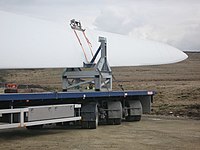 |
Heavy transport trailer with all-wheel steering remote controlled by a steersman walking at the rear of the trailer (2008). |
 |
2007 Liebherr-Bauma telescopic handler using crab steering. |
our-wheel steering (or all-wheel steering) is a system employed by some vehicles to improve steering response, increase vehicle stability while maneuvering at high speed, or to decrease turning radius at low speed.
Active four-wheel steering
In an active four-wheel steering system, all four wheels turn at the same time when the driver steers. In most active four-wheel steering systems, the rear wheels are steered by a computer and actuators. The rear wheels generally cannot turn as far as the front wheels. There can be controls to switch off the rear steer and options to steer only the rear wheels independently of the front wheels. At low speed (e.g. parking) the rear wheels turn opposite of the front wheels, reducing the turning radius by up to twenty-five percent, sometimes critical for large trucks or tractors and vehicles with trailers, while at higher speeds both front and rear wheels turn alike (electronically controlled), so that the vehicle may change position with less yaw, enhancing straight-line stability. The "snaking effect" experienced during motorway drives while towing a travel trailer is thus largely nullified.Four-wheel steering found its most widespread use in monster trucks, where maneuverability in small arenas is critical, and it is also popular in large farm vehicles and trucks. Some of the modern European Intercity buses also utilize four-wheel steering to assist maneuverability in bus terminals, and also to improve road stability. The first rally vehicle to use the technology was the Peugeot 405 Turbo 16. Its debut was at the 1988 Pikes Peak International Hill Climb, where it set a record breaking time of 10:47.77. The car would go on to victory in the 1989 and 1990 Paris-Dakar Rally, again driven by Ari Vatanen.
Previously, Honda had four-wheel steering as an option in their 1987–2001 Prelude and Honda Ascot Innova models (1992–1996). Mazda also offered four-wheel steering on the 626 and MX6 in 1988. General Motors offered Delphi's Quadrasteer in their consumer Silverado/Sierra and Suburban/Yukon. However, only 16,500 vehicles were sold with this system from its introduction in 2002 through 2004. Due to this low demand, GM discontinued the technology at the end of the 2005 model year. Nissan/Infiniti offer several versions of their HICAS system as standard or as an option in much of their line-up. A new "Active Drive" system is introduced on the 2008 version of the Renault Laguna line. It was designed as one of several measures to increase security and stability. The Active Drive should lower the effects of under steer and decrease the chances of spinning by diverting part of the G-forces generated in a turn from the front to the rear tires. At low speeds the turning circle can be tightened so parking and maneuvering is easier.Crab steering
Crab steering is a special type of active four-wheel steering. It operates by steering all wheels in the same direction and at the same angle. Crab steering is used when the vehicle needs to proceed in a straight line but under an angle (i.e. when moving loads with a reach truck, or during filming with a camera dolly), or when the rear wheels may not follow the front wheel tracks (i.e. to reduce soil compaction when using rolling farm equipment).
Passive rear wheel steering
Many modern vehicles have passive rear steering. On many vehicles, when cornering, the rear wheels tend to steer slightly to the outside of a turn, which can reduce stability. The passive steering system uses the lateral forces generated in a turn (through suspension geometry) and the bushings to correct this tendency and steer the wheels slightly to the inside of the corner. This improves the stability of the car, through the turn. This effect is called compliance understeer and it, or its opposite, is present on all suspensions. Typical methods of achieving compliance understeer are to use a Watt's link on a live rear axle, or the use of toe control bushings on a twist beam suspension. On an independent rear suspension it is normally achieved by changing the rates of the rubber bushings in the suspension. Some suspensions typically have compliance oversteer due to geometry, such as Hotchkiss live axles or a semi-trailing arm IRS, but may be mitigated by revisions to the pivot points of the leaf spring or trailing arm.Passive rear wheel steering is not a new concept, as it has been in use for many years, although not always recognised as such.
Articulated steering
 |
Front loader with articulated steering (2007). |
Rear wheel steering
A few types of vehicle use only rear wheel steering, notably fork lift trucks, camera dollies, early pay loaders, Buckminster Fuller's Dymaxion car, and the ThrustSSC.
Rear wheel steering tends to be unstable because in turns the steering geometry changes hence decreasing the turn radius (over steer), rather than increase it (under steer). Rear wheel steering is meant for slower vehicles that need high-maneuverability in tight spaces, e.g. fork lifts.Steer-by-wire
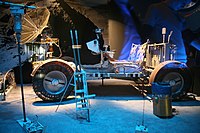 |
1971 Lunar Roving Vehicle (LRV) with joystick steering controls. |
 |
2012 Honda EV-STER "Twin Lever Steering" concept. |
he aim of
steer-by-wire technology is to completely do away with as many mechanical components (steering shaft, column, gear reduction mechanism, etc.) as possible. Completely replacing conventional steering system with steer-by-wire holds several advantages, such as:
- The absence of steering column simplifies the car interior design.
- The absence of steering shaft, column and gear reduction mechanism allows much better space utilization in the engine compartment.
- The steering mechanism can be designed and installed as a modular unit.
- Without mechanical connection between the steering wheel and the road wheel, it is less likely that the impact of a frontal crash will force the steering wheel to intrude into the driver's survival space.
- Steering system characteristics can easily and infinitely be adjusted to optimize the steering response and feel.
As of 2007 there are no production cars available that rely solely on steer-by-wire technology due to safety, reliability and economic concerns, but this technology has been demonstrated in numerous concept cars and the similar fly-by-wire technology is in use in both military and civilian aviation applications. Removing the mechanical steering linkage in road going vehicles would require new legislation in most countries.Safety
For safety reasons all modern cars feature a collapsible steering column (energy absorbing steering column) which will collapse in the event of a heavy frontal impact to avoid excessive injuries to the driver. Airbags are also generally fitted as standard. Non-collapsible steering columns fitted to older vehicles very often impaled drivers in frontal crashes, particularly when the steering box or rack was mounted in front of the front axle line, at the front of the crumple zone. This was particularly a problem on vehicles that had a rigid separate chassis frame, with no crumple zone. Most modern vehicle steering boxes/racks are mounted behind the front axle on the front bulkhead, at the rear of the front crumple zone.
Collapsible steering columns were invented by Bela Barenyi and were introduced in the 1959 Mercedes-Benz W111 Fintail, along with crumple zones. This safety feature first appeared on cars built by General Motors after an extensive and very public lobbying campaign enacted by Ralph Nader. Ford started to install collapsible steering columns in 1968.Audi used a retractable steering wheel and seat belt tensioning system called procon-ten, but it has since been discontinued in favor of airbags and pyrotechnic seat belt pre-tensioners.
Cycles
Steering is crucial to the stability of bicycles and motorcycles. For details, see articles on bicycle and motorcycle dynamics and countersteering. Steering monocycles and unicycles is especially complicated.Watercraft steering
Ships and boats are usually steered with a rudder. Depending on the size of the vessel, rudders can be manually actuated, or operated using a servomechanism, or a trim tab/servo tab system. Boats using outboard motors steer by rotating the entire drive unit. Boats with inboard motors sometimes steer by rotating the propeller pod only (i.e. Volvo Penta IPS drive). Modern ships with diesel-electric drive use azimuth thrusters. Boats driven by oars (i.e. rowing boats, including gondolas) or paddles (i.e. canoes, kayaks, rafts) are steered by generating a higher propulsion force on the side of the boat opposite of the direction of turn. Jet skis are steered by weight-shift induced roll and water jet thrust vectoring. Water skis and surfboards are steered by weight-shift induced roll only.
Aircraft and hovercraft steering
Airplanes are normally steered by the use of ailerons to bank the aircraft into a turn - the rudder is used to minimise adverse yaw, rather than as a means to directly cause the turn. Missiles, airships and hovercraft are usually steered by rudder and/or thrust vectoring. Jet packs and flying platforms are steered by thrust vectoring only. Helicopters are steered by cyclic control, changing the thrust vector of the main rotor(s), and by anti-torque control, usually provided by a tail rotor (see helicopter flight controls).Other types of steering
Tunnel boring machines are steered by hydraulic tilting of the cutter head. Rail track vehicles (i.e. trains, trams) are steered by curved guide tracks, including switches, and articulated undercarriages. Land yachts on wheels and kite buggies are steered similarly to cars. Ice yachts and bobsleighs are steered by rotating the front runners out of the direction of travel. Snowmobiles steer the same way by rotating the front skis. Tracked vehicles (i.e. tanks) steer by increasing the drive force on the side opposite of the direction of turn. Horse-drawn sleighs and dog sleds are steered by changing the direction of pull. Zero-turn lawn mowers use independent hydraulic wheel drive to turn on the spot.





















No comments:
Post a Comment